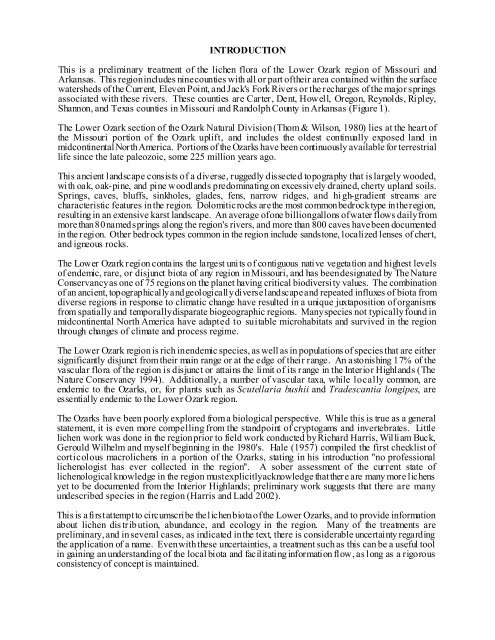lichens of the lower ozark region of missouri and arkansas
lichens of the lower ozark region of missouri and arkansas
lichens of the lower ozark region of missouri and arkansas
Create successful ePaper yourself
Turn your PDF publications into a flip-book with our unique Google optimized e-Paper software.
INTRODUCTION<br />
This is a preliminary treatment <strong>of</strong> <strong>the</strong> lichen flora <strong>of</strong> <strong>the</strong> Lower Ozark <strong>region</strong> <strong>of</strong> Missouri <strong>and</strong><br />
Arkansas. This <strong>region</strong> includes nine counties with all or part <strong>of</strong> <strong>the</strong>ir area contained within <strong>the</strong> surface<br />
watersheds <strong>of</strong> <strong>the</strong> Current, Eleven Point, <strong>and</strong> Jack's Fork Rivers or <strong>the</strong> recharges <strong>of</strong> <strong>the</strong> major springs<br />
associated with <strong>the</strong>se rivers. These counties are Carter, Dent, Howell, Oregon, Reynolds, Ri pley,<br />
Shannon, <strong>and</strong> Texas counties in Missouri <strong>and</strong> R<strong>and</strong>olph County in Arkansas (Figure 1).<br />
The Lower Ozark section <strong>of</strong> <strong>the</strong> Ozark Natural Division (Thom & Wilson, 1980) lies at <strong>the</strong> heart <strong>of</strong><br />
<strong>the</strong> Missouri portion <strong>of</strong> <strong>the</strong> Ozark uplift, <strong>and</strong> includes <strong>the</strong> oldest continually exposed l<strong>and</strong> in<br />
midcontinental North America. Portions <strong>of</strong> <strong>the</strong> Ozarks have been continuously available for terrestrial<br />
life since <strong>the</strong> late paleozoic, some 225 million years ago.<br />
This ancient l <strong>and</strong>scape consists <strong>of</strong> a diverse, ruggedly dissected topography that is largely wooded,<br />
wi th oak, oak-pine, <strong>and</strong> pine woodl<strong>and</strong>s predominating on excessively drained, cherty upl<strong>and</strong> soils.<br />
Springs, caves, bluffs, sinkholes, glades, fens, narrow ridges, <strong>and</strong> high-gradient streams are<br />
characteristic features in <strong>the</strong> <strong>region</strong>. Dolomitic rocks are <strong>the</strong> most common bedrock type in <strong>the</strong> <strong>region</strong>,<br />
resulting in an extensive karst l<strong>and</strong>scape. An average <strong>of</strong> one billion gallons <strong>of</strong> water flows daily from<br />
more than 80 named springs along <strong>the</strong> <strong>region</strong>'s rivers, <strong>and</strong> more than 800 caves have been documented<br />
in <strong>the</strong> <strong>region</strong>. O<strong>the</strong>r bedrock types common in <strong>the</strong> <strong>region</strong> include s<strong>and</strong>stone, localized lenses <strong>of</strong> chert,<br />
<strong>and</strong> igneous rocks.<br />
The Lower Ozark <strong>region</strong> contains <strong>the</strong> largest uni ts <strong>of</strong> contiguous native vegetation <strong>and</strong> highest levels<br />
<strong>of</strong> endemic, rare, or disjunct biota <strong>of</strong> any <strong>region</strong> in Missouri, <strong>and</strong> has been designated by The Nature<br />
Conservancy as one <strong>of</strong> 75 <strong>region</strong>s on <strong>the</strong> planet having critical biodiversity values. The combination<br />
<strong>of</strong> an ancient, topographically <strong>and</strong> geologically diverse l<strong>and</strong>scape <strong>and</strong> repeated influxes <strong>of</strong> biota from<br />
diverse <strong>region</strong>s in response to climatic change have resulted in a unique juxtaposition <strong>of</strong> organisms<br />
from spatially <strong>and</strong> temporally disparate biogeographic <strong>region</strong>s. Many species not typically found in<br />
midcontinental North America have adapted to suitable microhabitats <strong>and</strong> survived in <strong>the</strong> <strong>region</strong><br />
through changes <strong>of</strong> climate <strong>and</strong> process regime.<br />
The Lower Ozark <strong>region</strong> is rich in endemic species, as well as in populations <strong>of</strong> species that are ei<strong>the</strong>r<br />
significantly disjunct from <strong>the</strong>ir main range or at <strong>the</strong> edge <strong>of</strong> <strong>the</strong>ir range. An astonishing 17% <strong>of</strong> <strong>the</strong><br />
vascular flora <strong>of</strong> <strong>the</strong> <strong>region</strong> is disjunct or attains <strong>the</strong> limit <strong>of</strong> its range in <strong>the</strong> Interior Highl<strong>and</strong>s (The<br />
Nature Conservancy 1994). Additionally, a number <strong>of</strong> vascular taxa, while locally common, are<br />
endemic to <strong>the</strong> Ozarks, or, for plants such as Scutellaria bushii <strong>and</strong> Tradescantia longipes, are<br />
essentially endemic to <strong>the</strong> Lower Ozark <strong>region</strong>.<br />
The Ozarks have been poorly explored from a biological perspective. While this is true as a general<br />
statement, it is even more compelling from <strong>the</strong> st<strong>and</strong>point <strong>of</strong> cryptogams <strong>and</strong> invertebrates. Little<br />
lichen work was done in <strong>the</strong> <strong>region</strong> prior to field work conducted by Richard Harris, William Buck,<br />
Gerould Wilhelm <strong>and</strong> myself beginning in <strong>the</strong> 1980's. Hale (1957) compiled <strong>the</strong> first checklist <strong>of</strong><br />
corticolous macro<strong>lichens</strong> in a portion <strong>of</strong> <strong>the</strong> Ozarks, stating in his introduction "no pr<strong>of</strong>essional<br />
lichenologist has ever collected in <strong>the</strong> <strong>region</strong>". A sober assessment <strong>of</strong> <strong>the</strong> current state <strong>of</strong><br />
lichenological knowledge in <strong>the</strong> <strong>region</strong> must explicitly acknowledge that <strong>the</strong>re are many more <strong>lichens</strong><br />
yet to be documented from <strong>the</strong> Interior Highl<strong>and</strong>s; preliminary work suggests that <strong>the</strong>re are many<br />
undescribed species in <strong>the</strong> <strong>region</strong> (Harris <strong>and</strong> Ladd 2002).<br />
This is a first attempt to circumscribe <strong>the</strong> lichen biota <strong>of</strong> <strong>the</strong> Lower Ozarks, <strong>and</strong> to provide information<br />
about lichen dis tribution, abundance, <strong>and</strong> ecology in <strong>the</strong> <strong>region</strong>. Many <strong>of</strong> <strong>the</strong> treatments are<br />
preliminary, <strong>and</strong> in several cases, as indicated in <strong>the</strong> text, <strong>the</strong>re is considerable uncertainty regarding<br />
<strong>the</strong> application <strong>of</strong> a name. Even with <strong>the</strong>se uncertainties, a treatment such as this can be a useful tool<br />
in gaining an underst<strong>and</strong>ing <strong>of</strong> <strong>the</strong> local biota <strong>and</strong> facilitating information flow, as long as a rigorous<br />
consistency <strong>of</strong> concept is maintained.


